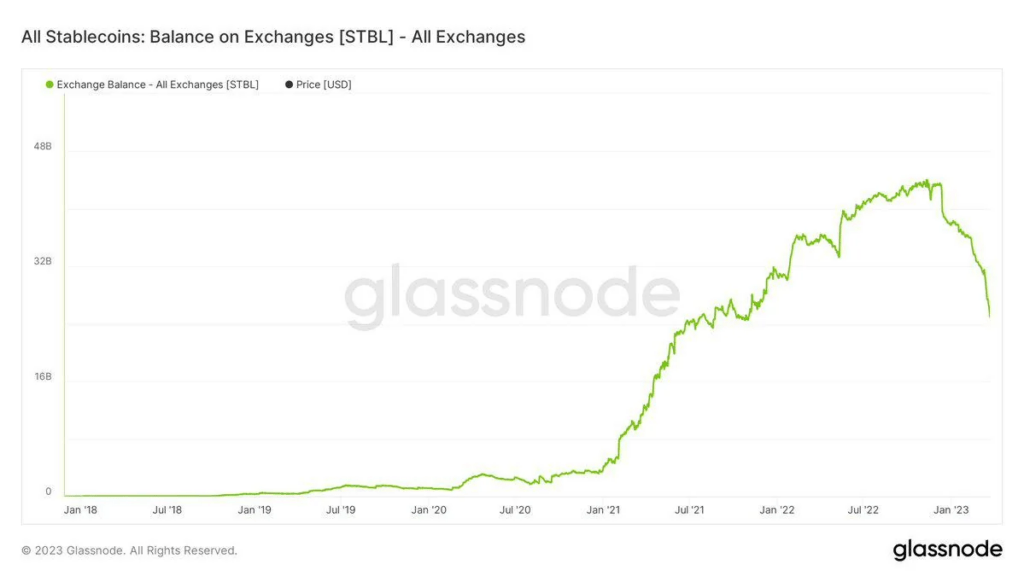Stablecoin supply on cryptocurrency exchanges down 50% in 4 months

Glassnode data on Mar. 26 shows that the stablecoin supply on exchanges has more than halved to less than $24b in four months.
Stablecoin supply on exchanges dropping
In November, stablecoin supply on exchanges stood at over $44b. Still, this figure, triggered by several fundamental factors, including regulatory actions, has been contracting over the months.
As of writing, only about $24b is held in various cryptocurrency exchanges, with analysts who believe that a big chunk might have been converted to other crypto assets, including bitcoin (BTC) and ethereum (ETH), or solid cash like the USD.

Stablecoin Balance on exchanges by Glassnode
In crypto, stablecoins track the value of other assets perceived to be stable. Stablecoins tracking fiat currencies like the USD are popular.
The common ones include USDT, a token present in multiple blockchains like Tron and Ethereum, issued by Tether Holdings. It is pegged to the USD. Its issuers claim the token is sufficiently backed by cash and cash equivalents, including United States short-term securities like Treasuries. Other alternatives include USDC by Circle, BUSD by Paxos, and DAI, an algorithmic stablecoin by MakerDAO minted only on Ethereum.
Historically, stablecoins have served as conduits, allowing users to channel funds from traditional finance to the cryptocurrency market.
Since stablecoins are theoretically “stable” and divergent from crypto assets like bitcoin, which are volatile, tokens like DAI, USDT, and USDC can act as shields when crypto prices are under liquidation pressure.
Regulatory changes and stablecoins de-pegging
There could be several explanations behind the sharp contraction of stablecoin supply on exchanges.
Last month, the New York Department of Financial Services (NYDFS) ordered Paxos, the issuer of BUSD, a stablecoin, to halt the minting of new tokens. It comes hours after the United States Securities and Exchange Commission (SEC) issued a Wells Notice to Paxos, claiming that BUSD was a security. This forced BUSD holders to convert to other stablecoins and assets, mostly USDT and USDC.
Days later, the bank run at Silicon Valley Bank (SVB) impacted Circle, the issuer of USDC. Circle had $3.3b stuck in SVB. This triggered panic in the markets, forcing USDC to de-peg as users rushed to exit for USDT, which at that time was trading at a premium. The exit from USDC also impacted DAI, which de-pegged.
BREAKING: $USDC depegs to $0.94 as Circle confirms ~8.25% of $USDC reserves are in the collapsed #SiliconValleyBank. pic.twitter.com/FQnyJ6DVPo
— CoinGecko (@coingecko) March 11, 2023
Analysts point out that the destabilization of stablecoins and increasing regulatory pressure may be why token holders could be exiting to currencies of legacy networks, including bitcoin. When writing on Mar. 26, bitcoin is trading at $27,831, up 15% in the last month.






 Bitcoin
Bitcoin  Ethereum
Ethereum  Tether
Tether  USDC
USDC  Dogecoin
Dogecoin  TRON
TRON  Cardano
Cardano  Chainlink
Chainlink  Stellar
Stellar  Bitcoin Cash
Bitcoin Cash  Hedera
Hedera  LEO Token
LEO Token  Litecoin
Litecoin  Cronos
Cronos  Monero
Monero  Dai
Dai  OKB
OKB  Ethereum Classic
Ethereum Classic  Gate
Gate  KuCoin
KuCoin  VeChain
VeChain  Cosmos Hub
Cosmos Hub  Algorand
Algorand  Tether Gold
Tether Gold  Stacks
Stacks  Zcash
Zcash  Theta Network
Theta Network  Tezos
Tezos  IOTA
IOTA  TrueUSD
TrueUSD  NEO
NEO  Decred
Decred  Dash
Dash  Qtum
Qtum  Basic Attention
Basic Attention  Synthetix Network
Synthetix Network  Zilliqa
Zilliqa  0x Protocol
0x Protocol  Ravencoin
Ravencoin  Holo
Holo  Siacoin
Siacoin  DigiByte
DigiByte  Enjin Coin
Enjin Coin  Numeraire
Numeraire  Ontology
Ontology  Nano
Nano  Waves
Waves  Status
Status  Hive
Hive  Huobi
Huobi  Lisk
Lisk  Steem
Steem  Pax Dollar
Pax Dollar  BUSD
BUSD  OMG Network
OMG Network  Bitcoin Gold
Bitcoin Gold  NEM
NEM  Augur
Augur